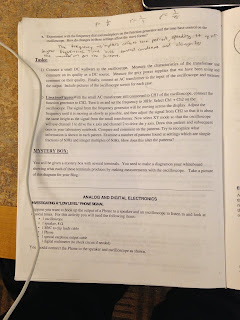 |
| When we attach a function generator to a speaker, we see that increasing the frequency of the function creates a higher pitched sound, and increasing the voltage increases the volume. |
 |
| The sin function setting on the function generator creates a sine function on the screen. |
 |
| Setting the function generator to the square setting produces this image on the oscilloscope screen. |
 |
| This is the image produced by an alternating current. |
 |
| The following pictures were answers to the activities from the book that we had to do. |
 |
| These are our observations from every possible combination of voltages that could be delivered to the oscilloscope from the mystery box. |








No comments:
Post a Comment